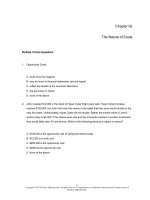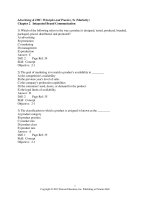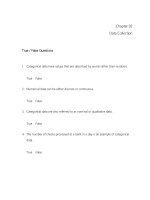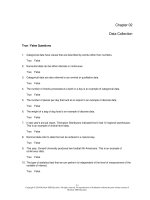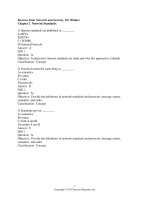Business data networks and security 9th edition panko test bank
Bạn đang xem bản rút gọn của tài liệu. Xem và tải ngay bản đầy đủ của tài liệu tại đây (278.6 KB, 14 trang )
Business Data Networks and Security, 9e (Panko)
Chapter 2 Network Standards
1) Network standards are also called protocols.
Answer: TRUE
2) Standards govern ________.
A) semantics
B) syntax
C) Both A and B
D) Neither A nor B
Answer: C
3) The meaning of a message is referred to as the message's ________.
A) protocol
B) order
C) value
D) semantics
Answer: D
4) How a message is organized is its ________.
A) syntax
B) semantics
C) order
D) Both A and B
Answer: A
5) In HTTP, a server may initiate an interaction with the client.
Answer: FALSE
6) Host P transmits a SYN to Host Q. If host Q is willing to open the connection, it will transmit
a(n) ________ segment.
A) ACK
B) SYN
C) SYN/ACK
D) None of the above
Answer: C
7) If the destination host does not receive a segment, it will ________.
A) transmit an ACK segment
B) transmit a NAC segment
C) transmit an RSND segment
D) None of the above
Answer: D
1
Copyright © 2013 Pearson Education, Inc. Publishing as Prentice Hall
8) If the destination host receives a segment that has an error, it will ________.
A) transmit an ACK segment
B) transmit a NAC segment
C) transmit an RST segment
D) None of the above
Answer: D
9) A sending host will retransmit a TCP segment if ________.
A) it receives an ACK segment
B) it receives a NAC segment
C) RPT
D) None of the above
Answer: D
10) The side wishing to close a TCP segment sends a(n) ________ segment.
A) SYN
B) ACK
C) FIN
D) None of the above
Answer: C
11) After the side wishing to close a TCP connection sends a FIN segment, it will ________.
A) not send any more segments
B) only send ACK segments
C) only send FIN segments
D) None of the above
Answer: B
12) Which of the following is not one of the three general parts of messages?
A) Address field.
B) Header.
C) Data field.
D) Trailer.
Answer: A
13) The ________ contains the content being delivered by a message.
A) address field
B) header
C) data field
D) trailer
Answer: C
14) The header is defined as everything that comes before the data field.
Answer: TRUE
15) Messages always have data fields.
Answer: FALSE
2
Copyright © 2013 Pearson Education, Inc. Publishing as Prentice Hall
16) The trailer is defined as everything that comes after the data field.
Answer: TRUE
17) Most messages have trailers.
Answer: FALSE
18) Headers usually are divided into fields.
Answer: TRUE
19) "Octet" is the same as ________.
A) "bit"
B) "byte"
C) Either A or B, depending on the context
D) Neither A nor B
Answer: B
20) Ethernet addresses are ________.
A) 32 bits long
B) 48 bits long
C) 128 bits long
D) None of the above
Answer: B
21) Ethernet addresses are ________ long.
A) 4 octets
B) 6 octets
C) 32 octets
D) 48 octets
Answer: B
22) ________ read(s) the destination MAC address in an Ethernet frame.
A) The destination host
B) Switches in the network
C) Both A and B
D) Neither A nor B
Answer: C
23) If the destination host finds an error in an Ethernet frame, it ________.
A) sends back a NAK
B) retransmits the frame
C) Both A and B
D) Neither A nor B
Answer: D
3
Copyright © 2013 Pearson Education, Inc. Publishing as Prentice Hall
24) Ethernet does ________.
A) error detection
B) error correction
C) Both A and B
D) Neither A nor B
Answer: A
25) Ethernet detects errors but does not correct them. Therefore, Ethernet is reliable.
Answer: FALSE
26) In an IP header, the first bit in the second row is bit ________.
A) 0
B) 31
C) 32
D) None of the above
Answer: C
27) How long are IPv4 addresses?
A) 32 octets.
B) 48 bits.
C) 20 octets.
D) None of the above
Answer: D
28) How long are IPv4 addresses?
A) 4 octets.
B) 6 octets.
C) 20 octets.
D) 32 octets.
Answer: A
29) Routers make forward decisions based on a packet's source IP address.
Answer: FALSE
30) Routers make packet forwarding decisions based on a packet's ________.
A) source IP address
B) destination IP address
C) Both A and B
Answer: B
31) IP is reliable.
Answer: FALSE
32) IP detects errors but does not correct them. Therefore, IP is reliable.
Answer: FALSE
4
Copyright © 2013 Pearson Education, Inc. Publishing as Prentice Hall
33) To handle internetwork transmission control tasks that IP cannot handle, the IETF created
TCP.
Answer: TRUE
34) TCP messages are called ________.
A) frames
B) fragments
C) packets
D) None of the above
Answer: D
35) One-bit fields are called ________ fields.
A) binary
B) flag
C) ACK
D) None of the above
Answer: B
36) If someone says that a 1-bit flag is set, this means that it is given the value ________.
A) 0
B) 1
C) Either A or B
D) Neither A nor B
Answer: B
37) If the ACK bit is set, the acknowledgement number field MUST have a value.
Answer: TRUE
38) Which of the following has a header checksum field?
A) TCP.
B) UDP.
C) Both A and B
D) Neither A nor B
Answer: C
39) UDP checks messages for errors but does not correct them. UDP is ________.
A) reliable
B) unreliable
C) Both A and B
D) Neither A nor B
Answer: B
5
Copyright © 2013 Pearson Education, Inc. Publishing as Prentice Hall
40) On a server, well-known port numbers indicate ________.
A) applications
B) connections with client computers
C) Both A and B
D) Neither A nor B
Answer: A
41) On a client, ephemeral port numbers indicate ________.
A) applications
B) connections with servers
C) Both A and B
D) Neither A nor B
Answer: B
42) The range 1024 to 4999 is the usual range for ________ port numbers.
A) well-known
B) ephemeral
C) Both A and B
Answer: B
43) 6,000 is in the range for ________ port numbers.
A) well-known
B) ephemeral
C) Both A and B
D) Neither A nor B
Answer: D
44) An IP address, a colon, and a port number constitute a(n) ________.
A) well-known port number
B) ephemeral port number
C) connection
D) socket
Answer: D
45) The application layer standard always is HTTP.
Answer: FALSE
46) Which of the following layers has the most standards?
A) Data link.
B) Internet.
C) Transport.
D) Application.
Answer: D
6
Copyright © 2013 Pearson Education, Inc. Publishing as Prentice Hall
47) Which layer has more standards?
A) Internet.
B) Application.
C) Both of the above have about the same number of standards.
Answer: B
48) At which layer would you find standards for requesting videos from a video sharing site such
as YouTube?
A) Application.
B) Transport.
C) Internet.
D) None of the above
Answer: A
49) At which layer would you find file transfer protocol standards for downloading files?
A) Application.
B) Transport.
C) Internet.
D) None of the above
Answer: A
50) Nearly all application standards are simple, like HTTP.
Answer: FALSE
51) In HTTP, most response message header fields consist of a keyword, an equal sign, and the
value for the keyword.
Answer: FALSE
52) In HTTP, the end of a header field is indicated by a ________.
A) byte position
B) CRLF
C) colon
D) blank line
Answer: B
53) An HTTP request message usually has a ________.
A) header
B) data field
C) Both A and B
D) Neither A nor B
Answer: A
7
Copyright © 2013 Pearson Education, Inc. Publishing as Prentice Hall
54) An HTTP response message usually has a ________.
A) trailer
B) data field
C) Both A and B
D) Neither A nor B
Answer: A
55) Converting application messages into bits is called ________.
A) encapsulation
B) encryption
C) encoding
D) conversion
Answer: C
56) At what layer is encoding done?
A) Application.
B) Transport.
C) Internet.
D) None of the above
Answer: A
57) How many bytes will it take to transmit "Brain Dead" without the quotation marks?
A) 2
B) 3
C) 9
D) None of the above
Answer: D
58) How many bytes will it take to transmit "Can you hear me now?" without the quotation
marks?
A) 5
B) 6
C) 10
D) None of the above
Answer: D
59) Binary counting usually begins at 1.
Answer: FALSE
60) In binary, 13 is 1101. What is 14?
A) 1110
B) 1111
C) Neither A nor B
Answer: A
61) If you have a field with N bits, you can represent N2 items.
Answer: FALSE
8
Copyright © 2013 Pearson Education, Inc. Publishing as Prentice Hall
62) A 5-bit field can represent ________ alternatives.
A) 8
B) 16
C) 32
D) 64
Answer: C
63) Increasing an alternatives field length by one bit always doubles the number of alternatives it
can represent.
Answer: TRUE
64) A 7-bit field can represent ________ alternatives.
A) 14
B) 49
C) 128
D) 256
Answer: C
65) To represent 65 alternatives, your alternatives field would have to be ________ bits long.
A) 5
B) 6
C) 7
D) 8
Answer: C
66) The electrical signal generated by a microphone is called a(n) ________ signal.
A) binary
B) digital
C) analog
D) Either A or B
Answer: A
67) A codec ________.
A) encodes voice signals into analog signals
B) encodes voice signals into binary signals
C) compresses the signal
D) Both B and C
Answer: A
68) ________ is placing a message in the data field of another message.
A) Encryption
B) Vertical communication
C) Layering
D) Encapsulation
Answer: D
9
Copyright © 2013 Pearson Education, Inc. Publishing as Prentice Hall
69) After the internet layer process does encapsulation, it passes the IP packet to the ________
layer process.
A) transport
B) data link
C) physical
D) None of the above
Answer: B
70) After the data link layer process does encapsulation, it passes the IP packet to the ________
layer process.
A) physical
B) internet
C) transport
D) None of the above
Answer: A
71) Which layer process does not do encapsulation when an application layer process transmits a
message?
A) Physical.
B) Data link.
C) Internet.
D) All do encapsulation.
Answer: A
72) Network standards architectures break the standards functionality needed for communication
into layers and define the functions of each layer.
Answer: TRUE
73) Which of the following is a network standards architecture?
A) ISO.
B) TCP/IP.
C) Both A and B
D) Neither A nor B
Answer: B
74) A corporate network can use either OSI standards at all layers or TCP/IP standards at all
layers, but cannot use OSI standards at some layers and TCP/IP standards at other layers.
Answer: FALSE
75) What is the dominant network standards architecture in most real firms today?
A) OSI.
B) TCP/IP.
C) Neither A nor B
Answer: C
10
Copyright © 2013 Pearson Education, Inc. Publishing as Prentice Hall
76) Which of the following is a standards agency for OSI?
A) IETF.
B) ITU-T.
C) Both A and B
D) Neither A nor B
Answer: B
77) Which of the following is a network standards architecture?
A) ISO.
B) OSI.
C) Both A and B
D) Neither A nor B
Answer: B
78) OSI is dominant at the ________ layer.
A) physical
B) internet
C) Both A and B
D) Neither A nor B
Answer: A
79) OSI is dominant at the ________ layer.
A) data link
B) transport
C) Both A and B
D) Neither A nor B
Answer: A
80) OSI is dominant at the ________ layer.
A) internet
B) transport
C) Both A and B
D) Neither A nor B
Answer: D
81) Which of the following is an architecture?
A) IP.
B) TCP.
C) Both A and B
D) Neither A nor B
Answer: D
11
Copyright © 2013 Pearson Education, Inc. Publishing as Prentice Hall
82) Which of the following is a standard?
A) TCP/IP.
B) IP.
C) Both A and B
D) Neither A nor B
Answer: B
83) Which of the following is a standards agency for TCP/IP?
A) ITU-T.
B) IETF.
C) OSI.
D) None of the above
Answer: B
84) TCP/IP became dominant in corporations primarily because of ________.
A) its use on the Internet
B) its relatively simple standards, which led to low costs
C) a government mandate
D) All of the above
Answer: B
85) Most IETF documents are called ________.
A) official internet standards
B) TCP/IP standards
C) RFCs
D) None of the above
Answer: B
86) TCP/IP is dominant at the ________ layer(s).
A) physical
B) internet
C) Both A and B
D) Neither A nor B
Answer: B
87) TCP/IP is dominant at the ________ layer(s).
A) data link
B) transport
C) Both A and B
D) Neither A nor B
Answer: B
12
Copyright © 2013 Pearson Education, Inc. Publishing as Prentice Hall
88) TCP/IP is dominant at the ________ layer(s).
A) physical
B) data link
C) Both A and B
D) Neither A nor B
Answer: D
89) Which standards architecture is dominant at the application layer?
A) OSI.
B) TCP/IP.
C) IEEE.
D) None of the above
Answer: D
90) Almost all applications, regardless of what standards architecture they come from, can run
over TCP/IP standards at the internet and transport layers.
Answer: TRUE
91) Which layer(s) of the hybrid TCP/IP—OSI standards architecture normally use(s) OSI
standards?
A) Data link.
B) Transport.
C) Both A and B
D) Neither A nor B
Answer: A
92) Which layer(s) of the hybrid TCP/IP—OSI standards architecture normally use(s) TCP/IP
standards?
A) Data link.
B) Transport.
C) Both A and B
D) Neither A nor B
Answer: B
93) Wireless LAN transmission normally is governed by ________ standards.
A) OSI
B) TCP/IP
C) Both A and B
D) Neither A nor B
Answer: A
94) Switched WAN transmission is governed by ________ standards.
A) OSI
B) TCP/IP
C) Both A and B
D) Neither A nor B
Answer: A
13
Copyright © 2013 Pearson Education, Inc. Publishing as Prentice Hall
95) The OSI ________ layer allows application communication to be restarted at the last
rollback point.
A) application
B) presentation
C) session
D) None of the above
Answer: C
96) The OSI ________ layer is designed to handle data formatting differences between two
computers.
A) application
B) presentation
C) session
D) None of the above
Answer: B
97) The OSI ________ layer is designed to handle compression and encryption for applications.
A) application
B) presentation
C) session
D) None of the above
Answer: A
98) The OSI presentation layer is actually used ________.
A) to convert between file formats
B) as a category for data file standards used by multiple applications
C) Both A and B
D) Neither A nor B
Answer: B
99) Which of the following is NOT an OSI layer name?
A) Data link.
B) Internet.
C) Session.
D) Presentation.
Answer: C
100) In OSI, the presentation layer is Layer ________.
A) 7
B) 6
C) 5
D) None of the above
Answer: B
14
Copyright © 2013 Pearson Education, Inc. Publishing as Prentice Hall
